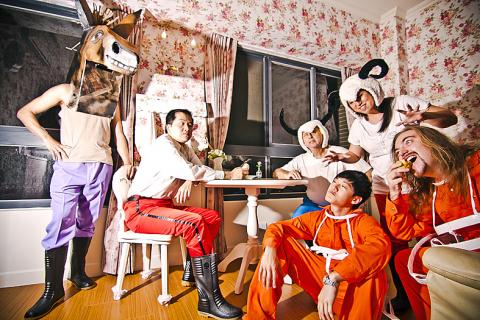In Ham’s Brave New Ward (他媽的,哈姆的,悲劇), a play that opens tonight at the Red House Theater (西門紅樓) in Taipei, a psychiatric patient suffers from Shakespearean delusions.
Ham, played by British expat Adam Raphael, lives in a psychiatric asylum and experiences hallucinations in which he believes he is Hamlet.
Since Ham only communicates by speaking in lines from The Tragedy of Hamlet, his doctors — played by Indiana Zhao (趙鴻欣), Cherry Lee (李純臻), Rick Lin (林皓陽) and American expat Jeremy Cook — decide to act out Shakespeare’s play with their patient in the hope of bringing him back to reality.

Photo courtesy of Corny Chicken E.W. Cross Cultural Theater
The production is the brainchild of female actor and director Tu Ye-fei (涂也斐), who leads the Corny Chicken E.W. Cross Culture Theater (玉米雞之意外跨文化劇團). The Hsinchu-based group, whose goofy-sounding name has to do with its roots as a children’s musical theater, moved back into contemporary theater in 2009 with the play Who Killed Confucius? (誰殺了孔夫子).
Tu has a master’s degree in theater and drama from National Taiwan University and wrote Ham’s Brave New Ward seven years ago while working for Crown Theater (皇冠小劇場), an experimental theater group in Taipei.
This time around, she has revised her play to accommodate the bilingual, bicultural cast — expect to hear lots of Shakespearean English intertwined with Mandarin. (There will be subtitles for both languages displayed for the production, which runs 80 minutes.)
But the obscurities of language shouldn’t be a problem, says Tu, who is counting on slapstick and zany costumes to keep the audience engaged. Adding to an already colorful mix will be a few video interludes and segments of Taiwanese Opera.
Corny Chicken is advertising Ham’s Brave New Ward as a comedy, but Tu hopes audiences come away with a little more than just an evening of laughs.
“I try to deal with the relationship between Hamlet and women,” Tu said. “For me, Hamlet is a very patriarchal character.”

Even by the standards of Ukraine’s International Legion, which comprises volunteers from over 55 countries, Han has an unusual backstory. Born in Taichung, he grew up in Costa Rica — then one of Taiwan’s diplomatic allies — where a relative worked for the embassy. After attending an American international high school in San Jose, Costa Rica’s capital, Han — who prefers to use only his given name for OPSEC (operations security) reasons — moved to the US in his teens. He attended Penn State University before returning to Taiwan to work in the semiconductor industry in Kaohsiung, where he

On May 2, Chinese Nationalist Party (KMT) Chairman Eric Chu (朱立倫), at a meeting in support of Taipei city councilors at party headquarters, compared President William Lai (賴清德) to Hitler. Chu claimed that unlike any other democracy worldwide in history, no other leader was rooting out opposing parties like Lai and the Democratic Progressive Party (DPP). That his statements are wildly inaccurate was not the point. It was a rallying cry, not a history lesson. This was intentional to provoke the international diplomatic community into a response, which was promptly provided. Both the German and Israeli offices issued statements on Facebook

May 18 to May 24 Pastor Yang Hsu’s (楊煦) congregation was shocked upon seeing the land he chose to build his orphanage. It was surrounded by mountains on three sides, and the only way to access it was to cross a river by foot. The soil was poor due to runoff, and large rocks strewn across the plot prevented much from growing. In addition, there was no running water or electricity. But it was all Yang could afford. He and his Indigenous Atayal wife Lin Feng-ying (林鳳英) had already been caring for 24 orphans in their home, and they were in

Australia’s ABC last week published a piece on the recall campaign. The article emphasized the divisions in Taiwanese society and blamed the recall for worsening them. It quotes a supporter of the Taiwan People’s Party (TPP) as saying “I’m 43 years old, born and raised here, and I’ve never seen the country this divided in my entire life.” Apparently, as an adult, she slept through the post-election violence in 2000 and 2004 by the Chinese Nationalist Party (KMT), the veiled coup threats by the military when Chen Shui-bian (陳水扁) became president, the 2006 Red Shirt protests against him ginned up by